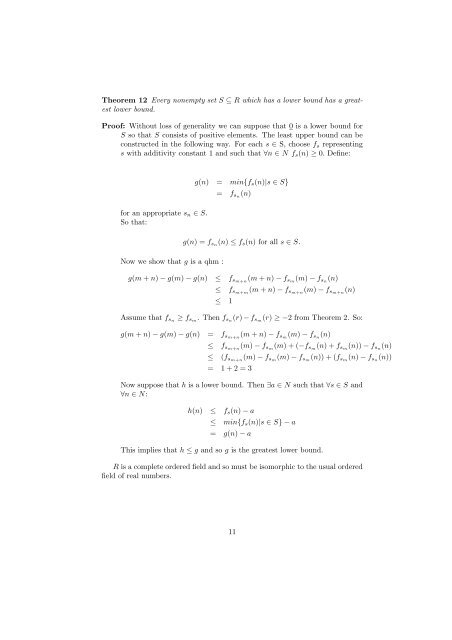The Efficient Real Numbers - Macquarie University
The Efficient Real Numbers - Macquarie University
The Efficient Real Numbers - Macquarie University
You also want an ePaper? Increase the reach of your titles
YUMPU automatically turns print PDFs into web optimized ePapers that Google loves.
<strong>The</strong>orem 12 Every nonempty set S ⊆ R which has a lower bound has a greatest<br />
lower bound.<br />
Proof: Without loss of generality we can suppose that 0 is a lower bound for<br />
S so that S consists of positive elements. <strong>The</strong> least upper bound can be<br />
constructed in the following way. For each s ∈ S, choose fs representing<br />
s with additivity constant 1 and such that ∀n ∈ N fs(n) ≥ 0. Define:<br />
for an appropriate sn ∈ S.<br />
So that:<br />
Now we show that g is a qhm :<br />
g(n) = min{fs(n)|s ∈ S}<br />
= fsn (n)<br />
g(n) = fsn (n) ≤ fs(n) for all s ∈ S.<br />
g(m + n) − g(m) − g(n) ≤ fsm+n (m + n) − fsm (m) − fsn (n)<br />
≤ fsm+m (m + n) − fsm+n (m) − fsm+n (n)<br />
≤ 1<br />
Assume that fsn ≥ fsm . <strong>The</strong>n fsn (r) −fsm (r) ≥ −2 from <strong>The</strong>orem 2. So:<br />
g(m + n) − g(m) − g(n) = fsm+n (m + n) − fsm (m) − fsn (n)<br />
≤ fsm+n (m) − fsm (m) + (−fsm (n) + fsm (n)) − fsn (n)<br />
≤ (fsm+n (m) − fsm (m) − fsm (n)) + (fsm (n) − fsn (n))<br />
= 1 + 2 = 3<br />
Now suppose that h is a lower bound. <strong>The</strong>n ∃a ∈ N such that ∀s ∈ S and<br />
∀n ∈ N:<br />
h(n) ≤ fs(n) − a<br />
≤ min{fs(n)|s ∈ S} − a<br />
= g(n) − a<br />
This implies that h ≤ g and so g is the greatest lower bound.<br />
R is a complete ordered field and so must be isomorphic to the usual ordered<br />
field of real numbers.<br />
11
















